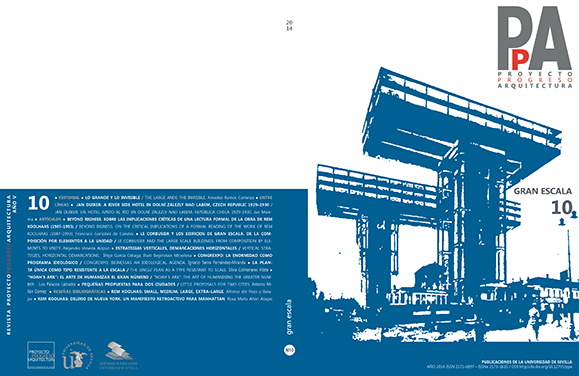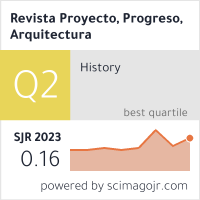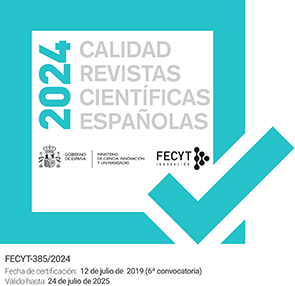“NOAH´S ARK”: EL ARTE DE HUMANIZAR EL GRAN NÚMERO / “Noah´s Ark”: the art of humanising the greater number
DOI:
https://doi.org/10.12795/ppa.2014.i10.07Parole chiave:
“el gran número”, Aldo Van Eyck, configuración, Piet Blom, Team X, estructuralismo holandés / “the greater number”, configuration, Dutch structuralismAbstract
RESUMEN 1962. Royaumont (Francia). Debate del Team 10 entorno a las grandes estructuras urbanas. Van Eyck presentó la propuesta “Noah´s Ark”, obra de su mejor estudiante, Piet Blom, como ejemplo que aunaba arquitectura y urbanismo para afrontar la gran escala; para “humanizar el gran número” en la difícil tarea de construir para las masas. Ensalzado por unos y criticado duramente por otros, el proyecto desató la polémica en el seno del Team 10.
Alison Smithson, encargada de recoger los encuentros del grupo y una de las mayores críticas del proyecto, dejó fuera de la publicación “Team 10 Primer” todo pasaje que elogiaba “Noah´s Ark”. Blom, desesperado, destrozó la maqueta y regaló los planos del proyecto, que años después se perderían.
El presente artículo se centra en la recuperación del proyecto “Noah´s Ark” y su valoración como punto de inflexión entre dos corrientes culturales: fue el máximo exponente del pensamiento configurativo, desarrollado por Van Eyck en la década de los años 50 y anunció las características de un incipiente movimiento en arquitectura: el estructuralismo holandés. El artículo destaca la influencia de “Noah´s Ark” como claro punto de partida, inspiración o germen proyectual para obras de mayor repercusión en la historia de la arquitectura, como el Hospital de Venecia de Le Corbusier y Jullian de la Fuente.
SUMMARY 1962. Royaumont (France). Team 10’s debate about large urban structures. Van Eyck presented the “Noah´s Ark” proposal, work of his favourite student, Piet Blom, as an example which combined architecture and urbanism to confront the large scale; to “humanise the greater number” in the difficult task of building for the masses. Praised by some, and harshly criticised by others, the project unleashed controversy in the heart of Team 10.
Alison Smithson, who minuted the meetings of the group, and one of the greatest critics of the project, omitted all passages that praised “Noah´s Ark”from the publication “Team 10 Primer”. Blom, exasperated, destroyed the scale model and gave away the plans of the project, which would be lost years later.
The present article is focused on the recovery of the “Noah´s Ark” project and its assessment as aturning point between two cultural currents: it was the maximum exponent of the configurative thought, developed by Van Eyck in the 1950s, and announced the characteristics of an incipient architectural movement, Dutch structuralism. The article emphasises the influence of “Noah´s Ark” as a clear departure point, inspiration or seed for the design of works of greater repercussion in the history of architecture, such as the Venice Hospital project of Le Corbusier and Jullian de la Fuente.
Downloads
Riferimenti bibliografici
Allard, Pablo: “Bridge over Venice”. En Sarkis, Hashim: Case: Le Corbusier´s Venice Hospital and the Mat Building Revival. Munich: Prestel Verlag, 2001. pp 18-35.
Bakema, Jaap.: “Building houses for anonymous employers”. En Forum. 1962, Nº 2. pp. 75-77.
Bakema, Jaap.: “Hacia una arquitectura total”. En Cuadernos Summa-Nueva visión. 1970, Nº 52-53. Madrid: Nueva Visión. 1968-1970. pp. 7-9.
Beerends, Arnauld: “A structure for the city hall of Amsterdam”. En Tabk. 1969, Nº 1. pp. 13-15.
Behm, Maaike; Kloos, Maarten: Hertzberger’s Amsterdam. Amsterdam: ARCAM, 2007.
Bohigas, Oriol: “Aldo van Eyck or a New Amsterdam School”. En Oppositions. 1977, Nº 9. pp. 21-41.
Chateau Gannon, Francisco: “Yellow peripherical distinction: Guillermo Jullian en el encuentro del Team X en Berlín, 1973”. En Massilia: anuario de estudio lecorbusierianos. 2007. pp. 76-89.
de la Fuente, G. Jullian: “Notes sur Royaumont”. En Le Carré Bleu. 1963, Nº 2.
di Palma, Vittoria; Periton, Diana; Lathouri, Marina: Intimate Metropolis. Urban Subjects in the Modern City. London: Routledge, 2009. PMCid:PMC3178446
Hengeveld, Jaap: Piet Blom. Amersfoort (the Netherlands): Hengeveld Publicaties, 2008. PMCid:PMC2753771
Hertzberger, Herman: Aldo van Eyck. Amsterdam: Stichting Wonen/Van Loghum Slaterus, 1982.
Hertzberger, Herman: “Study for an urban grid, commentary on a study plan for the Amsterdam School of Architecture”. En Tabk. 1968, Nº 17. pp. 410-430.
Heuvel, Wim J.: Structuralism in Dutch architecture. Rotterdam: Uitgeverij 010 Publishers, 1992.
Lüchinger, Arnulf: “Structuralism, a new trend in architecture”. En Bauen und Wohnen. Enero 1976, Vol. 30, Nº 1.
Lüchinger, Arnulf: Structuralism in Architecture and Urban Planning. Stuttgart, 1981.
Mandelbrot, Benoît: Les objets fractals: forme, hazard et dimension. Paris: Flammarion, 1975. PMid:16578734 PMCid:PMC433088
Martin, John Leslie; Nicholson, Ben; Gabo, Naum: Plastic Art and pure Plastic Art. London: Circle, 1937.
Nicolin, Pierluigi: “Aldo van Eyck. The Web and the Labyrinth”. En Lotus international. 1976, Vol. 11. pp. 105-138.
O’Byrne Orozco, C.: El proyecto para el Hospital de Venecia de Le Corbusier. Director: Jose Francisco Quetglas Riusech. Tesis doctoral. Universitat Politècnica de Catalunya, Departamento de Proyectos Arquitectónicos, 2008.
Ockman, Joan: Architecture Culture 1943-1968. New York: Rizzoli International Publications, 1993.
Pestalozzi Village. Forum. Nº 1. 1963.
Pueblos. Forum. Nº 3. 1962.
Risselada, Max; Van den Heuvel, Dirk: Team 10, 1953-81, in search of a Utopia of the present. Rotterdam: Nai Publishers, 2005.
Sarkis, Hashim: Case: Le Corbusier´s Venice Hospital and the Mat Building Revival. Munich: Prestel Verlag, 2001.
Smithson, Alison: “How to Recognise and Read Mat-Building”. En Architectural design. Septiembre 1974. pp. 573-590.
Smithson, Alison: “Team 10 at Royaumont”. En Architectural design. Noviembre 1975, Nº 11. pp. 679-690.
Smithson, Alison: Team 10 primer. Cambridge (Massachusetts): MIT Press, 1974. PMid:4854556
Smithson, Alison: Team 10 Meetings, 1953-1984. New York: Rizzoli International Publications, 1991.
Special Issue: Piet Blom. Tabk (Architecture and Visual Arts Magazine). Nº 22. Octubre 1969.
Strauven, Francis: Aldo Van Eyck. The Shape of Relativity. Amsterdam: Architectura & Natura, 1998.
Strauven, Francis; Ligtelijn, Vincent: Collected Articles and Other Writings 1947-1998. Amsterdam: SUN Publishers, 2008. PMid:18945611
Valena, Tomás: Structuralism reloaded. Ruled-based Design in Architecture and Urbanism. Stuttgart-London: Ed. Axel Mende, 2011.
Van den Broek & Bakema. Cuadernos summa nueva visión. Nº 52-53. 1970. Madrid: Nueva Visión. 1968-1970.
Van Eyck, Aldo: The Child, the City and the Artist. Amsterdam: Sun Publishers, 1962. PMid:13924566
Van Eyck, Aldo: “The fake client and the great word no”. En Forum. Agosto 1962, Nº 3. pp. 79-80.
Van Eyck, Aldo: “Steps towards a configurative discipline”. En Forum. Agosto 1962, Nº 3. pp. 81-94.
##submission.downloads##
Pubblicato
Come citare
Fascicolo
Sezione
Licenza
Las ediciones impresa y electrónica de esta Revista son editadas por el Secretariado de Publicaciones de la Universidad de Sevilla, siendo necesario citar la procedencia en cualquier reproducción parcial o total.
Salvo indicación contraria, todos los contenidos de la edición electrónica se distribuyen bajo una licencia de uso y distribución “Creative Commons Atribución-NoComercial-SinDerivar 4.0 Internacional” ![]() . Puede consultar desde aquí la versión informativa y el texto legal de la licencia. Esta circunstancia ha de hacerse constar expresamente de esta forma cuando sea necesario.
. Puede consultar desde aquí la versión informativa y el texto legal de la licencia. Esta circunstancia ha de hacerse constar expresamente de esta forma cuando sea necesario.
Los autores/as que publiquen en esta revista aceptan las siguientes condiciones:
- Los autores/as conservan los derechos de autor y ceden a la revista el derecho de la primera publicación, con el trabajo registrado con la licencia de atribución de Creative Commons, que permite a terceros utilizar lo publicado siempre que mencionen la autoría del trabajo y a la primera publicación en esta revista.
- Los autores/as pueden realizar otros acuerdos contractuales independientes y adicionales para la distribución no exclusiva de la versión del artículo publicado en esta revista (p. ej., incluirlo en un repositorio institucional o publicarlo en un libro) siempre que indiquen claramente que el trabajo se publicó por primera vez en esta revista.
- Se permite y recomienda a los autores/as a publicar su trabajo en Internet (por ejemplo en páginas institucionales o personales) antes y durante el proceso de revisión y publicación, ya que puede conducir a intercambios productivos y a una mayor y más rápida difusión del trabajo publicado (vea The Effect of Open Access).









